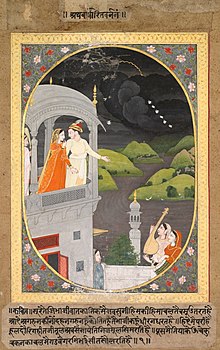바라마사
Barahmasa
바라흐마사(불빛) "12개월")은 주로 인도의 민속[1][2][3] 전통에서 유래한 인도 아대륙에서 인기 있는 시적 장르다.[4] 그것은 대개 자신의 부재중인 연인이나 남편을 그리워하는 여성을 중심으로 다루어지며, 지나가는 계절과 의식의 사건을 배경으로 그녀 자신의 감정 상태를 묘사한다.[5][6] (힌두교 음력에 따르면) 월의 진행은 장르의 근본적 요소지만, 월수는 반드시 바라(힌디: बारह)나 "12"가 아니며, 차우마스, 차이야마스, 재타다마(각각 4개월, 6개월, 8개월의 주기)로 알려진 이와 유사한 시적 형태도 같은 민속 사다리 혈통에 존재한다.식비[7]
비록 원래 구전 전통이지만, 이 장르는 빈갈리, 구자라티, 힌디, 라자스탄, 비하리, 푼자비 등 현대 인도-아리아 주요 언어에 걸쳐 있는 다수의 인도[8] 시인에 의해 더 긴 시, 서사, 서사시, 서사시 등으로 통합되었고, 부족 사람들의 민요에서도 찾아볼 수 있다.[9]
오리진스
어원
바라흐마사는 힌디어 바라(Hindi: बाह)가 '12'를 의미하고 마사(Hindi: ासस)'가 '월'을 뜻하는 데서 유래했다.[10] 비슷한 동족들은 벵골의 바라마시 같은 다른 언어에서 사용된다.[11]
문학

힌디어
바라하마스는 사아드-ṛ투('6계절') 장르와 함께 나하 카비의 비살데브라스[8][13](Bisaldev-ras) 등 아와디 프리마키아('로망스')[12]와 라자스타니 라사우스('발라드')에 편입되었고, 유명한 브라즈 바샤 시인 케샤바다의 작품에도 수록되었다.[14] 주로 라마-크리슈나의 숭배 주변에서 툴시다스와 수르다스의 주제가 된 몇몇 헌신적인 바라하마사도 발견되었다.[15][10]
바라흐마사는 처음에 힌디에서 나타났다가 점차 우르두에서도 나타났다. 오르시니에 따르면, 그것들은 "아마 1860년대 북-인도 상업 출판 붐의 첫 번째 실질적인 장르였을 것이다."[16]
벵골어
벵골어에서는 만갈-카브야로 알려진 일탈문학, 찬드라바티의 힌두교 서사시 라마야나 각색에 바오마시가 편입되어 시타에서는 1년 내내 라마와의 경험을 회상한다.[11]
페르시아어
페르시아어로 가장 초창기적이고 유일한 문학적인 바라흐마사는 사디살만이 작곡했다. 라호르에 살았던 그 시인은 아마도 인도의 민속적 관습에 영향을 받았을 것이다. 그러나 그 주제는 여자의 그리움도 아니고 연인들의 결합도 아니며, 이란의 달인 파바르딘으로부터 시작된다.[12]
구자라티
19세기 초, 시인 성 브라흐만드는 바라하마스를 재구성하고 스와미나라이안 삼프라다야의 신학을 편입시켰다. 그의 작문은 더 큰 크리슈나 바크티 시에 속한다.[17]
그림
이 장르는 또한 '분디 회화학교'와 같은 화가들과 회화학교들이 일년 중 다른 달을 묘사하는 여러 개의 미니어처 그림을 만들기 위해 사용되었다. 뉴델리 국립박물관에는 약 138점의 바라하마 그림이 있다. 이 그림들의 대부분은 18세기 후반에서 19세기 초에 속했다.[18]
참조
- ^ Raheja, Gloria Goodwin (2017). ""Hear the Tale of the Famine Year": Famine Policy, Oral Traditions, and the Recalcitrant Voice of the Colonized in Nineteenth-Century India". Oral Tradition. 31 (1). doi:10.1353/ort.2017.0005. hdl:10355/65381. ISSN 1542-4308. S2CID 164563056 – via Project MUSE.
This song was written in the traditional form of a barahmasa (a "song of the twelve months"). In central and northern India, this is almost entirely...
- ^ Raeside, I. M. P. (1988). "Bārahmāsā in Indian literatures. Songs of the twelve months in Indo-Aryan literatures. By Charlotte Vaudeville with a foreword by T. N. Madan. pp. xvi, 139. DelhiMotilal Banarsidass, 1986. (Revised and enlarged English edition, first pub. in French, 1965.) Rs. 70". Journal of the Royal Asiatic Society. 120 (1): 218. doi:10.1017/S0035869X00164652. ISSN 2051-2066.
- ^ Dwyer, Rachel; Dharampal-Frick, Gita; Kirloskar-Steinbach, Monika; Phalkey, Jahnavi (2016). "Monsoon". Key Concepts in Modern Indian Studies. NYU Press. ISBN 978-1-4798-2683-4 – via Project MUSE.
Conversely, the sixteenth century tradition of Hindi poetry known as Barahmasa (lit. ‘songs of the twelve months’), which also appears in...
- ^ Wadley, Susan Snow (2005). Essays on North Indian Folk Traditions. Orient Blackswan. p. 57. ISBN 978-81-8028-016-0.
Evidence indicates that the Barahmasa originated in folk poetry...
- ^ Orsini, Francesca (2010). "Barahmasas in Hindi and Urdu". In Orsini, Francesca (ed.). Before the divide: Hindi and Urdu literary culture. New Delhi: Orient BlackSwan. p. 143. ISBN 978-81-250-3829-0. OCLC 490757928.
- ^ Claus, Peter J.; Diamond, Sarah; Mills, Margaret Ann (2003). South Asian Folklore: An Encyclopedia : Afghanistan, Bangladesh, India, Nepal, Pakistan, Sri Lanka. Taylor & Francis. p. 52. ISBN 978-0-415-93919-5.
The primary focus is on the human year, as formed and mediated by the climatic year and its associated...through the psychological shoals of the annual cycle.
- ^ Alam, Muzaffar (2003). "The Culture and Politics of Persian in Precolonial Hindustan". In Pollock, Sheldon (ed.). Literary Cultures in History: Reconstructions from South Asia. University of California Press. ISBN 978-0-520-92673-8.
The succession of months is a fundamental component, but the number of months is not necessarily twelve. The songs known as chaumasas, chaymasas, and astamasas (cycles of four, six, and eight months, respectively) belong to same category. These are in some cases mere catalogs of seasonal festivals and read like a kind of calendar.
- ^ a b Orsini, Francesca (2010). "Barahmasas in Hindi and Urdu". Before the divide : Hindi and Urdu literary culture. New Delhi: Orient BlackSwan. p. 147. ISBN 978-81-250-3829-0. OCLC 490757928.
- ^ Wadley, Susan Snow (2005). Essays on North Indian Folk Traditions. Orient Blackswan. p. 54. ISBN 978-81-8028-016-0.
- ^ a b Srivastava, P.K. (2016). "Separation and Longing in Viraha Barahmasa". The Delhi University Journal of the Humanities and the Social Sciences. 3: 43–56.
- ^ a b Bose, Mandakranta; Bose, Sarika Priyadarshini (2013). A Woman's Ramayana: Candrāvatī's Bengali Epic. Routledge. pp. 30–32. ISBN 978-1-135-07125-7.
- ^ a b Pandey, Shyam Manohar (1999). "Brahamasa in Candayan and in Folk Traditions". Studies in early modern Indo-Aryan Languages, Literature, and Culture : research papers, 1992–1994, presented at the Sixth Conference on Devotional Literature in New Indo-Aryan Languages, held at Seattle, University of Washington, 7–9 July 1994. Entwistle, A. W. New Delhi: Manohar Publishers & Distributors. pp. 287, 303, 306. ISBN 81-7304-269-1. OCLC 44413992.
- ^ Vaudeville, Charlotte (1986). Bārahmāsā in Indian Literatures: Songs of the Twelve Months in Indo-Aryan Literatures. Motilal Banarsidass. p. 12. ISBN 978-81-208-0185-1.
- ^ Sodhi, Jiwan (1999). A Study of Bundi School of Painting. Abhinav Publications. p. 54. ISBN 978-81-7017-347-2.
Amongs all these poets, the most popular was Keshavdasa, the renowned poet laureate of Raja Inderjit of Orchha. He gave new meaning to the Barahmasa...The Baramasa motif in Brajbhasha poetry not only gave freshness...
- ^ Vaudeville, Charlotte (1986). Bārahmāsā in Indian Literatures: Songs of the Twelve Months in Indo-Aryan Literatures. Motilal Banarsidass. p. 41. ISBN 978-81-208-0185-1.
...traditional barahamasas form in their religious works to the glories of Rama and Krishna...in fact a barahmasa attributed to Tulsidas...
- ^ Orsini, Francesca (2010). Orsini, Francesca (ed.). Before the divide: Hindi and Urdu literary culture. New Delhi: Orient BlackSwan. p. 169. ISBN 978-81-250-3829-0. OCLC 490757928.
- ^ Swaminarayan Hinduism : tradition, adaptation and identity. Williams, Raymond Brady., Trivedi, Yogi. (1st ed.). New Delhi, India: Oxford University Press. 2016. ISBN 978-0-19-908657-3. OCLC 948338914.
{{cite book}}: CS1 maint : 기타(링크) - ^ Beach, Milo Cleveland (1974). "Rajput Painting at Bundi and Kota". Artibus Asiae. Supplementum. 32: 55–56. doi:10.2307/1522680. ISSN 1423-0526. JSTOR 1522680.


